Join More Than 50,000+ Subscribers and get latest camera news and rumors
NEW CAMERA VIDEOS ON YOUTUBE
|
By admin, on March 1st, 2014
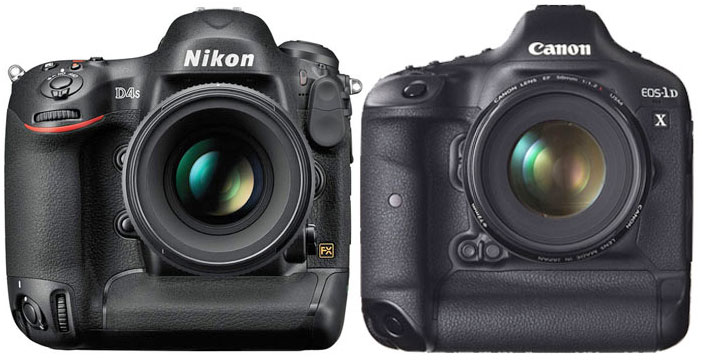
Nikon D4s is not a true successor of Nikon D4 DSLR, its just a speedy version of Nikon D4 camera that may fit easily more with sports shooters and photojournalist.
Now take a look at the specification comparison review of both the camera, does Nikon new Expeed 4 image processor is faster than Canon Dual Digic 5+ ?, find out your answer below…
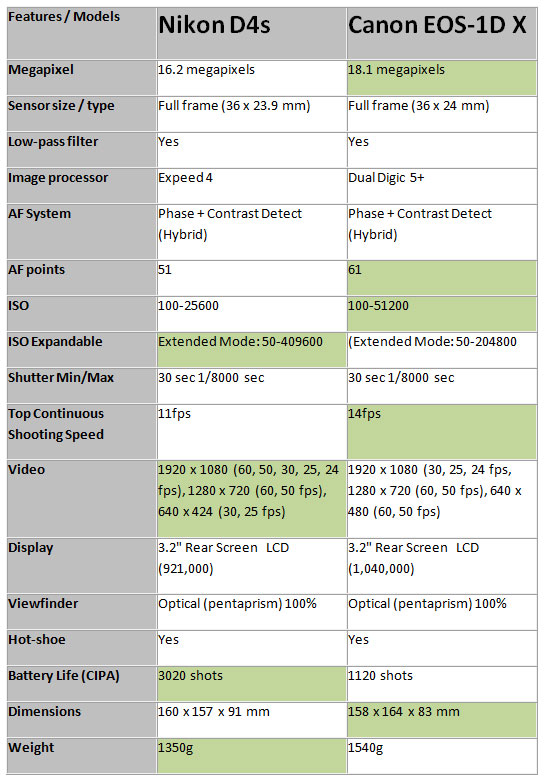
Sensor: The Nikon D4s features 16.2 megapixels Full frame (36 x 23.9 mm) CMOS Sensor same as of Nikon D4 DSLR, the increased ISO range in D4 is due to (standard upto 25600 and expandable upto 409600) the new Expeed 4 image processor, the Canon 1DX on the other hand features 18.1 megapixels Full frame (36 x 24 mm) CMOS Sensor 1-stop more standard ISO range and 1-stop less expandable ISO range when compared to Nikon D4 DSLR.
ISO performance:
|
Nikon D4s |
Canon 1D X |
| ISO Standard |
100-25600 |
100-51,200 |
| ISO Expandable |
50- 409600 |
50 – 204,800 |
Auto Focus
|
Nikon D4s |
Canon 1DX |
| Autofocus |
Number of focus points 51 |
Number of focus points 61 |
| Cross-Type Points |
15 |
41 (5 diagonal) |
| AF Sensor compatible with Apertures |
f/8 |
f/8 |
| AF Engine |
Multi-CAM 3500FX (same as D3) |
DIGIC IV |
| Predictive tracking |
Yes |
Yes |
Nikon D4s AF System
Nikon D4s features same (old) AF engine used in D3, D4 DSLR – Multi-CAM 3500FX autofocus sensor handles 51 AF points, aligns its 15 cross-type sensors in the central viewfinder area to detect contrast in both vertical and horizontal lines for better AF performance.
Nikon AF system is old, but comes with a upgraded AF Algorithm that features Group area AF, When Group-area AF is selected, the camera uses one focus point selected by the user and one each above, below, to the right, and to the left of the selected focus point, for a total of five focus points used as single AF point. It helps to capture speedy subjects with greater certainty without focus shifting to the background.
Canon 1DX AF System
Auto focus Points: The number of AF points and Cross/Type points canon wins, the Canon 1D X features 41 AF cross type points and 5 of the center points are oriented diagonally for faster AF performance.
AF Engine: Canon 1D X AF system uses dedicated Digic 4 processor , EOS-1D X’s comes with 61-point Area AF system that includes 41 cross-type sensors and 5 dual-cross type AF points for extra precision.
Canon 1D X offers six presets for different shooting situations, Each of these presets can be adjusted for ‘Tracking sensitivity’
For faster predictive focus measurements so that the EOS-1D X can begin predictive tracking as soon as a subject begins to move.
| Canon EOS-1D X AF mode presets, defined by subject behavior: |
| 1. Versatile multi purpose |
4. Subjects that accelerate or decelerate quickly |
| 2. Continue shooting, ignore obstructions |
5. Erratic Subject Movement |
| 3. Instantly refocus suddenly with obstructions |
6. Subjects that change speed and move erratically |
Six preset Case studies
There are six AF ‘Case studies’ preset within the EOS-1D X
- Case 1 is for general purpose shooting that provides accurate and fast focus across a wide range of shooting situations.
- Case 2 is designed for situations where the subject may move away from the AF point momentarily.
- Case 3 allows you to instantly focus on subjects that enter the AF point area.
- Case 4 is designed for subjects that change speed or direction rapidly.
- Case 5 is designed for use with automatic AF point selection, Zone AF and AF Point expansion and subjects that move erratically, up and down or left and right.
- Case 6 is for subjects that change speed abruptly and move erratically. Like ‘Case 5’ it is used with Automatic AF point selection, Zone AF and AF Point Expansion.
Continuous shooting
|
Nikon D4s |
Canon 1D X |
|
exposure and focusing is locked with the first frame
|
| Continuous shooting |
11 fps |
14 fps |
1DX that wins in the shooting speed, you get 3 extra frame per second in canon.
Video Shooting
|
Nikon D4s |
Canon 1D X |
| Video Shooting Format |
MPEG-4 / H.264 |
MPEG-4 / H.264 |
| Video Resolutions |
1920 x 1080 (60, 30, 25, 24 fps), 1280 x 720 (60, 50, 30, 25 fps), 640 x 424 (30, 25 fps) |
1920 x 1080 (30, 25, 24 fps, 1280 x 720 (60, 50 fps), 640 x 480 (60, 50 fps) |
| Video ISO Range |
200-204800 |
100-51200 |
Nikon gives you option to record your Fill HD videos @ 60fps frame rate however the Canon is limited to 30 fps frame rate at the Full HD mode, but not only that you get more extra benefit from Nikon D4s such as
- More Video ISO range in Nikon D4s DSLR.
- You can record 1,920 x 1,080/30p Full HD and HD movies in three formats that are FX-, DX-based and 1,920 x 1,080 crop movie format.
Nikon D4s with More shooting modes: With Canon 1D X you can use Canon EF lenses only, but with Nikon D4s you can use DX and FX lenses, Nikon D4s offers four image area options: FX format (36.0 x 23.9 mm), 5:4 crop (29.9 x 23.9 mm), 1.2x crop (29.9 x 19.9 mm) and DX format (23.4 x 15.5 mm). The camera also offers three image area options for Full HD video thereby tripling its potential for moviemaking.
Storage: 1DX coming with two slots of high-speed UDMA 7 Compact Flash cards, D4s also comes with two slots one for UDMA 7 and the other slot for the new XDC card format.
Conclusion: I think Nikon need a “Nikon D5” DSLR to beat the core specification of 1 year old Canon 1DX DSLR, The AF system of Canon 1DX is still advance and on the other hand Nikon features better video mode and expandable ISO range is 1 stop more than Canon 1DX (although the standard ISO range remains 1-Stop less than Canon 1DX)
For latest Price and Pre-order Nikon D4s visit Amazon, B&H and Adorama
Buy Canon 1D X from Amazon
By admin, on February 28th, 2014
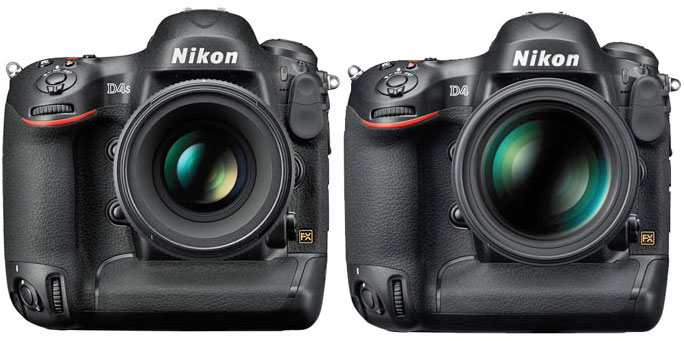
Nikon D4s vs Nikon D4, the newly developed DSLR bring many new features inside it that includes new sensor, fast image processor and better video mode, for more details take a look at the details below.
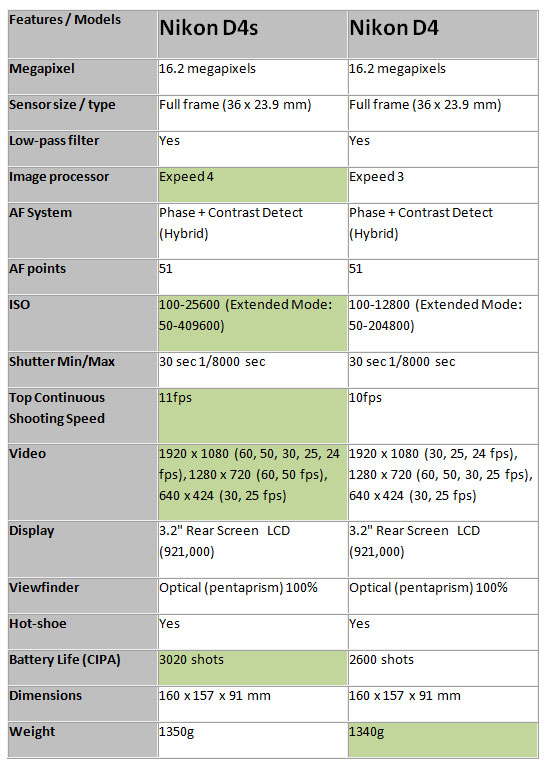
Increase in ISO range – Two factors inside the camera responsible for the ISO range first is sensor and second is image processor, form the High ISO test images that we have seen (included at the end of the post) we can clearly see better noise control (with bit less details) in D4s High ISO images so we conclude that
- The sensor quality is same as of Nikon D4
- Newly developed noise reduction algorithm work bit more aggressively inside Nikon D4s when compared to Nikon D4.
Fast Image Processor: Nikon added newly developed image processor inside Nikon D4s body, the new image processor is approx 30% faster than the old Expeed 3 image processor (according to Nikon). The Newly developed image processor also increases the AF speed of the camera upto 30% during test condition,
Nikon D4s comes with group area AF to quickly acquire the AF point for the first time: The five AF points of the center can be configured to utilize five AF points as a single focusing point in the Group Area AF setting for heightened initial subject recognition.
The Auto Focus module is same as Nikon D4 (Muilti CAM 3500 FX) but due to EXPEED 4 image processor the overall AF speed increases.
For more details about the improvement take a look at the table below.
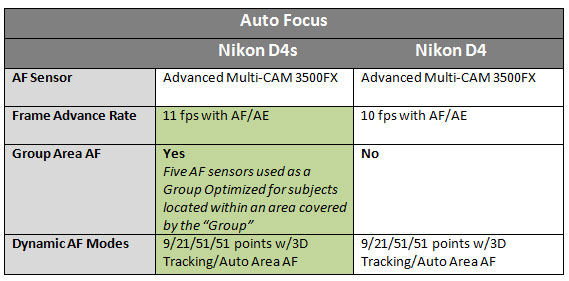
Video: Nikon D4s can now record videos upto 60fps at Full HD mode, + three formats are also available that include FX, DX and CX format, take a look at the table below for major difference between these two prime machine.
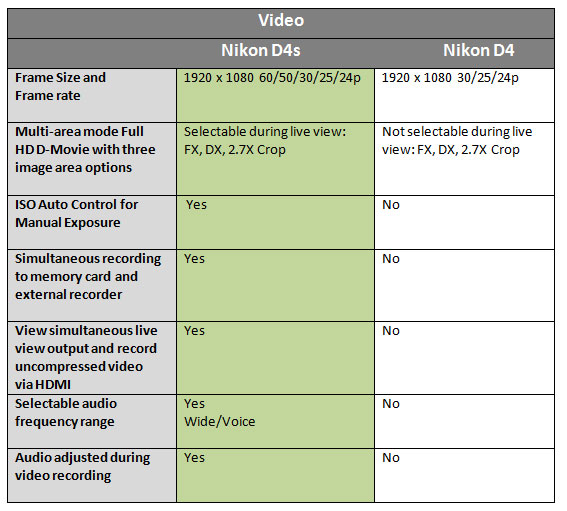
Nikon D4s vs Nikon D4 High ISO Test
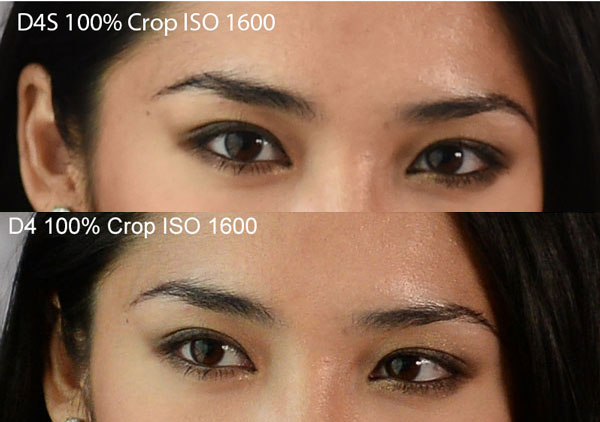
I really appreciate the effort made by Nikon to boost the ISO range to a next level, but when I see at comparison images taken at ISO 1600, the Nikon D4s noise reduction filter look bit strong compared to Nikon D4, as a result we can clearly see less noise + bit less details in the image samples. The Nikon D4s images look bit softer than the Nikon D4 images.
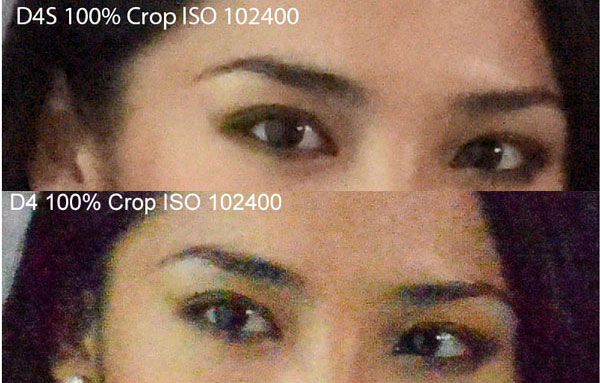
Verdict: Nikon D4s have many improvements over AF system and Video modes, you also get improved ISO range with D4, however base at ISO range the D4 look bit more sharp than D4s.
For Current D4 owners I will recommend you to wait for Nikon D5 DSLR to see major improvement over ISO range and AF system, for new users / buyers we highly recommend you to buy Nikon D4s.
For latest Price and Pre-order Nikon D4s visit Amazon, B&H and Adorama
By admin, on February 26th, 2014
Nikon D4s High ISO test images now surfaced over the web, the D4s supports High ISO upto 409600 and features newly developed sensor with Expeed 4 image processor which is approx 30% faster than the previous Expeed 3 processor

Does Nikon D4s images look bit soft at 100% when compared to Nikon D4 at lower ISO range.
I really appreciate the effort made by Nikon to boost the ISO range to a next level, but when I see at comparison images taken at ISO 1600, the Nikon D4s noise reduction filter look bit strong compared to Nikon D4 DSLR filter, and as a result we can clearly see less noise + bit less details in the image samples. The Nikon D4s images look bit softer than the Nikon D4 images.
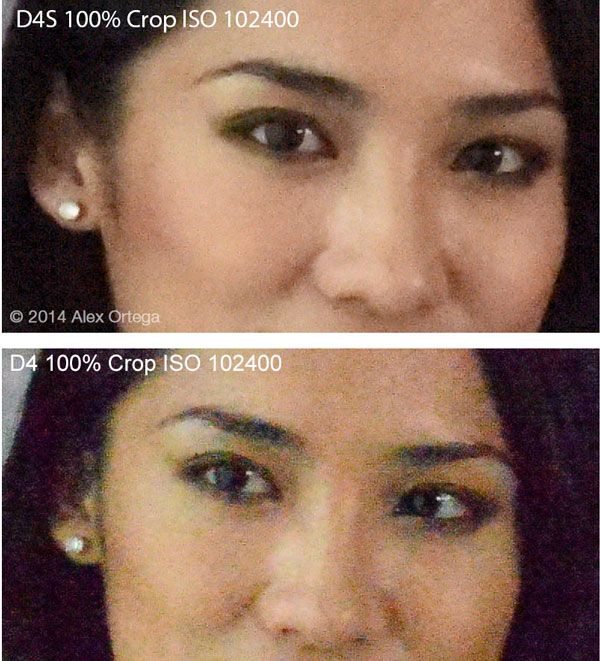
As we can see the effect of strong NR filter / new sensor / new image processor the image of Nikon D4s have less color noise in it.
more images available here – bit.ly/NxeMfq
By admin, on February 25th, 2014
Nikon D4s Sample Image surfaced over the web, the Nikon D4s features newly developed CMOS sensor and Expeed 4 image processor, with the introduction Expeed 4 image processor the AF speed is increased upto 30% and now Nikon D4s can shoot upto 11fps withh full time AF.
The images below captured in RAW mode and converted into JPEG via Capture NX 2.software without any editing.
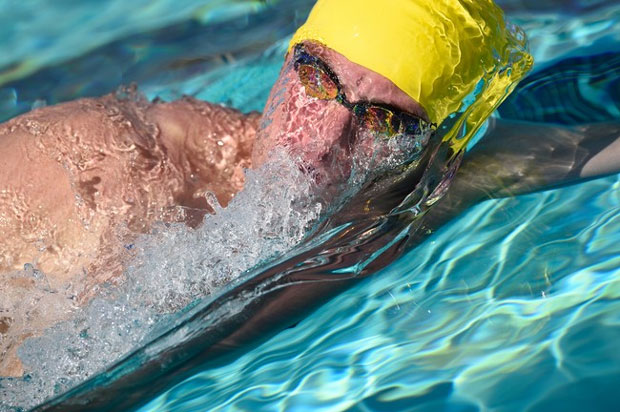
Shutter Speed: 1/4000, Aperture: f/5.6, ISO: 250
Continue reading Nikon D4s Sample Image
By admin, on February 25th, 2014
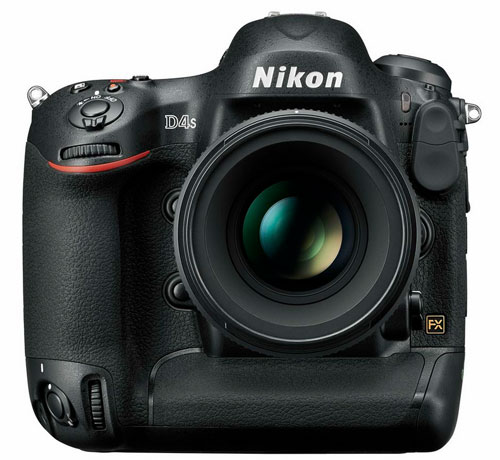
Finally the long rumored Nikon D4s announced today the camera features newly developed 16.2 megapixel full-frame (FX) CMOS sensor, the ISO native ISO range of the image sensor is 100-25600 and expandable upto 50-409600, achieving the ISO 409600 is complete breakthrough from Nikon and the Nikon D4s undoubtedly becomes the low-light king of camera industry.
RAW SIZES introduced in Nikon D4s DSLR, so you can now down-sample Raw files (probably, no more details available) and as usual DX mode is available for RAW and JPEG shooting with approx 1.5X crop factor.
The image processor used in Nikon D4s camera is Nikon EXPEED 4, the Nikon EXPEED 4 image processor is approx 30% faster than the previous generation of EXPEED 3 image processor used in the Nikon D4 DSLR, with the help of new image processor the camera can now capture 11fps of continuous shots with fulltime AF upto 200 JPEG and when you are working on RAW format the 14-bit RAW shooting mode, up to 104 shots can be recorded at 11 fps.
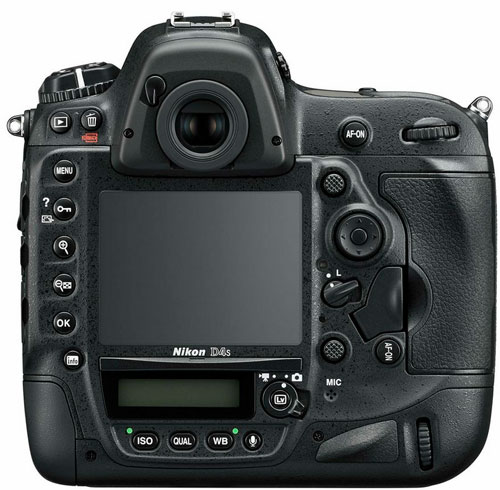
The AF engine is same here 51-Point Advanced Multi-CAM 3500FX AF Sensor, but due the advance image processor used + New AF algorithms supports 30% increase in AF speed compared to the Nikon D4 DSLR.
Nikon D4s can record Full HD videos 60fps frame rate, Nikon D4s supports FX and DX format lenses and also 2.7X crop factor. Nikon D4s can also record 2MP of still shot while recording videos.
No built in WiFi and NFC, users should use WT-5A and WT-4A Wireless Transmitters for optional WiFi transfer.
For latest Price and Pre-order Nikon D4s visit Amazon, B&H and Adorama
Press Release:
A next-generation flagship model offering advanced specifications that respond to the needs of professional photographers
TOKYO – Nikon Corporation is pleased to announce the release of the D4S, its latest flagship FX-format digital SLR camera.
Based on the D4, the D4S responds more completely to the demands of professional photographers with revisions to a number of features and functions, including AF performance, image quality, workflow and operation, and movie recording, adopted after running a variety of simulations of the functions required by professional photographers who sometimes find themselves working under quite severe conditions.
Algorithms used by the AF system have been refined for greater accuracy and versatility demanded by professional photographers. Autofocus is initiated faster and is better able to acquire and track the intended subject, whether it enters the frame suddenly or takes up the entire frame for a more powerful composition. In addition to the four time-tested modes available with the D4 (Single-point AF, Dynamic-area AF, 3D-tracking, and Auto-area AF), the D4S offers a fifth AF-area mode known as Group-area AF (uses 5 focus points: one specified by the user, as well as one each above, below, to the left, and to the right of the selected focus point). This mode enables not only smoother autofocusing, but also a faster workflow with continuous shooting at approximately 11 fps* with AF and AE tracking.
- *Measured according to CIPA guidelines. Value with shooting in AF-C autofocus mode, [S] or [M] exposure mode, shutter speed of 1/250 s or faster, all other settings at their default values.
The new EXPEED 4 image-processing engine, a new Nikon FX-format CMOS image sensor, and an effective pixel count of 16.2-million pixels enable capture of images that exhibit stunning sharpness, enhanced depth, and natural skin tones. A range of standard sensitivities from ISO 100 to ISO 25600 achieves images exhibiting sharper edges and smoother, more beautiful colors. The D4S also supports extended sensitivities as low as the equivalent of ISO 50 and as high as the equivalent of ISO 409600. What’s more, the accuracy of auto white balance has been increased for clear color reproduction, even with shooting under difficult artificial lighting.
A number of other improvements have been adopted without compromise in consideration of the advanced demands of professional photographers. Among these are improved viewfinder visibility with a more stable viewfinder image during continuous shooting and a shorter viewfinder blackout time, as well as smoother operation with less stress from a redesigned grip and refined layout of operational buttons and controls. Communication speed has also been increased with 1000BASE-T support for wired LAN communication, making extremely fast image transfer possible. A RAW S Small (12-bit uncompressed RAW) setting has also been added for faster post-capture editing on a computer.
The D4S supports movie recording at a frame size of 1920 x 1080 with a frame rate of 50p or 60p. EXPEED 4 enables rich tone reproduction, with very little noise, throughout the entire range of standard sensitivities (ISO 200-25600). Movies recorded at a 1920 x 1080 crop setting exhibit especially sharp and clear picture quality. Changes in exposure are also better controlled for smoother transition between frames with recording of scenes in which brightness changes greatly, even with time-lapse movies.
Development Background
Nikon’s flagship D4 camera, released in February 2012, expanded possibilities for photographic expression for professional photographers primarily in the fields of sports, press, and nature photography. The D4 offered a number of features that not only responded to the demands of professional photographers, but also enabled capture of images of decisive moments that moved those who saw the images. Among these were excellent performance over a broad range of sensitivities for superior image quality under difficult lighting conditions, fast and accurate AF capable of capturing the intended subject, the Advanced Scene Recognition System, which provided more advanced automatic control that allowed photographers to concentrate more fully on shooting itself, and support for the superior rendering characteristics of NIKKOR lenses developed with optical technologies only Nikon can offer. Moreover, the D4 also contributed to cultivating new possibilities for imaging expression with the ability to express shallow depths of field and maximize the characteristics of excellent performance at high sensitivities with movie recording.
Developed as the next-generation flagship successor to the D4, D4S functions, features, and performance were thoroughly examined and analyzed from a variety of angles, resulting in a digital SLR camera that responds more completely to the demands of professional photographers. With this background, the D4S was developed to embody Nikon’s response to the demands of professional photographers, upon which we place great importance, with functions and performance that support shooting in even the most difficult environments, and are able to respond to a variety of subjects and situations, as well as various lighting conditions.
D4S Primary Features
- Advanced AF performance that responds to the strict demands of professional photographers
High-performance AF that more accurately acquires and tracks the intended subject, even under extreme conditions
Reflection of ideas from professional photographers and repeated simulation of various advanced techniques they often use has resulted in the very precise subject acquisition and tracking performance that these photographers require, and upon which they can rely, under the most extreme conditions. Very precise adjustment of AF algorithms based on the Advanced Multi-CAM 3500FX autofocus sensor module enables certain acquisition of even erratically moving subjects and those exhibiting little in the way of contrast. D4S autofocus performs even better, keeping the acquired subject in focus, even when it is coming closer, or moving away, at high speed. What’s more, the D4S offers better balanced AF control with more precise focusing on the intended subject, and more accurate tracking of that subject, even when photographing team sports, such as soccer and rugby, when action may temporarily obstruct the intended subject.
5 AF-area modes for flexible focusing
In addition to the four time-tested modes built into the D4—Single-point AF, Dynamic-area AF (9-, 21-, 51-point), 3D-tracking, Auto-area AF—the D4S is equipped with a new Group-area AF AF-area mode for more powerful and versatile autofocusing. When Group-area AF is selected, the camera uses one focus point selected by the user and one each above, below, to the right, and to the left of the selected focus point, for a total of five focus points, for focusing. By capturing the subject within the five-point group, even if it is small and moving quickly and erratically as is often the case when photographing athletes and animals, the intended scene can be captured with greater certainty without focus shifting to the background.
In addition, an AF-area mode can be assigned to the AF activation button on super-telephoto NIKKOR lenses. When this is done, the specified AF-area mode is enabled while the AF activation button is held down. This enables strategic switching between the AF-area mode selected with the camera and a different AF-area mode assigned to the AF activation button, allowing users to switch back and forth between vital modes instantly, without ever taking their eye off the subject, when photographing a variety of scenes that change drastically. This allows users to better maximize AF performance between bursts of high-speed continuous shooting at approximately 11 fps* with AF and AE tracking.
- *Measured according to CIPA guidelines. Value with shooting in AF-C autofocus mode, [S] or [M] exposure mode, shutter speed of 1/250 s or faster, all other settings at their default values.
Powerful AF with a variety of combinations of NIKKOR lenses and teleconverters
The D4S is equipped with 51 focus points capable of acquiring the intended subject throughout the frame. 15 cross-type focus points at the center of the frame use phase-detection AF to detect the subject horizontally and vertically, and as all 51 focus points support a maximum aperture of f/5.6, the performance of line sensors and cross-type sensors is fully utilized with all AF NIKKOR lenses. In addition, the 15 focus points (9 at the center of the frame, and three each to the left and right of these 9)*1 support maximum apertures faster than f/8, and 11 focus points (9 running horizontally at the center of the frame and 1 each above and below)*2 support maximum apertures of f/8. This results in stress-free focusing, even when using 1.4x or 1.7x teleconverters, and certain autofocusing capability when a 2.0x teleconverter is used with super-telephoto NIKKOR lenses for a combined maximum aperture of f/8.
- *19 focus points at the center of the frame function as cross-type sensors; the remaining 6 focus points function as line sensors.
- *21 focus point at the center of the frame functions as a cross-type sensor; the remaining 10 focus points function as line sensors.
- Superior image quality with stunning sharpness and enhanced depth that responds more completely to the demands of professional photographers and supports the speed press photographers require
Beautiful image quality straight out of the camera
Press photographers working on-site demand not only certain capture of decisive moments, but also the ability to quickly transmit their photos as soon as they are taken. Understanding this need, the D4S captures JPEG images with stunning sharpness, enhanced depth, and natural skin tones that allows use of these images straight out of the camera. Less noise with shooting at high sensitivities and a range of standard sensitivities from ISO 100 to ISO 25600 enables images exhibiting sharper edges and smoother, more beautiful colors throughout the entire range (sensitivity can also be reduced to the equivalent of ISO 50 (Lo 1), or increased up to the equivalent of ISO 409600 (Hi 4) as shooting conditions demand). Images captured with the D4S also exhibit little significant loss in resolution, even when cropped for use in newspapers, magazines, or online. An effective pixel count of 16.2-million pixels, and the new EXPEED 4 image-processing engine and Nikon FX-format CMOS sensor, both developed by Nikon with meticulous research and repeated simulations, contribute greatly to these capabilities.
Accurate white balance for healthy skin tones and textures
Auto white balance achieves healthier, more vivid skin tones under a variety of lighting conditions. Adoption of a new image analysis system enables more accurate extraction and identification of white portions within the frame. In addition, as white balance can be fine-tuned in smaller steps than ever before, more precise settings can be specified. The D4S is also equipped with a spot white balance option that allows users to manually measure white balance data beforehand from even a very small white or gray portion of the frame. When the D4S is unable to accurately or satisfactorily measure preset white balance data, simply changing the area from which data is measured as many times as needed eliminates the need for repeating the process from the beginning. This helps to increase shooting efficiency for professional photographers who must work quickly when on-site.
- Exclusive Nikon technologies and functions for more convenient and smoother workflow
A high-performance viewfinder with greater visibility achieved with suppression of viewfinder image shake during continuous shooting
Improvements to components such as the mirror bouncer with the D4S suppress shake caused by mirror bound movement for more stable display of the viewfinder image. Viewfinder visibility with continuous shooting has also been improved with a shorter viewfinder blackout time and continuous display of the active focus point, even when the shutter is released.
RAW S Small* (12-bit uncompressed) image size option
A new RAW S Small option that records images using 1/4 the number of pixels used for full-sized RAW images has been added. This makes editing images on a computer after they have been taken faster and more convenient (file size is approximately 1/2 that of 12-bit uncompressed RAW L Large images).
- *Editing functions built into the camera and available from the Retouch menu, such as NEF (RAW) Processing and Image Overlay, cannot be applied to images captured at this setting.
1000BASE-T support
The D4S is equipped with an Ethernet connector (compatible with the 1000BASE-T standard) that enables smooth transfer of high-quality image data, regardless of the format in which it was recorded (JPEG, NEF, TIFF), after capture.
LCD monitor with function for customizing colors
The D4S is equipped with a 3.2-inch, approximately 921k-dot wide viewing angle TFT LCD monitor with which the protective glass and LCD panel have been integrated to suppress internal reflections. Display characteristics have been carefully adjusted for more faithful color reproduction. In addition, the camera is equipped with a function that allows users to customize colors to suit their individual preferences.
A form and layout for operational controls that make the camera easier to hold and operate
The shape of the grip has been optimized to make holding the camera more comfortable, even for those with small hands. What’s more, thorough examination of the shape of the rear of the camera, and design and materials used for the sub-selector have resulted in a camera that offers a better hold and more reliable operation.
- D-Movie function for recording full-HD 1920 x 1080 60p/50p movies
Movies recorded at a frame rate of 60p exhibit smooth subject movement and changes in exposure, even when the brightness of the scene changes greatly. Noise is effectively suppressed throughout the full range of standard sensitivities (ISO 200-25600) for rich expression of tones and stunning sharpness that preserves details. The D4S offers selection from three image area* options that respond to imaging intent—FX-based movie format, DX-based movie format, and 1920 x 1080 crop. With recording at a setting of 1920 x 1080 crop, 1920 x 1080p full-HD movies are generated without resizing for stunningly sharp movies rich in detail.
In addition, uncompressed movies can be recorded directly to an external HDMI device connected to the camera’s HDMI connector in movie live view mode. A dedicated HDMI cable clip is supplied with the D4S. When used with the optional HC-E1 HDMI cable, this clip prevents accidental disconnection of the HDMI cable from the camera. In addition, movie recording with the D4S is even more convenient as movies can be recorded to an external HDMI device and a memory card inserted in the camera at the same time.
The D4S responds to demands for movie recording with a variety of other capabilities as well, including the ability to change the image area in movie live view, and to enable Auto ISO Control for automatic adjustment of ISO sensitivity at a fixed shutter speed and aperture value.
The D4S also offers a new exposure smoothing function for time-lapse movie recording. This function smooths exposure between frames for less flicker in resulting movies.
- *Movies are recorded with an aspect ratio of 16 : 9 regardless of the format selected. Aspect ratio is 3 : 2 with recording at a frame size/rate of 640 x 424/30 fps and 640 x 424/25 fps.
Nikon D4s Full Specification
Specs:
| Body type |
| Body type |
Large SLR” |
| Body material |
Magnesium alloy |
| Sensor |
| Max resolution |
4928 x 3280 |
| Other resolutions |
4096 x 2720, 4096 x 3280, 3696 x 2456, 3200 x 2128, 3072 x 2456, 3072 x 2040, 2464 x 1640, 2400 x 1592, 2048 x 1360, 2048 x 1640, 1600 x 1064 |
| Image ratio w:h |
5:4, 3:2 |
| Effective pixels |
16 megapixels |
| Sensor photo detectors |
17 megapixels |
| Sensor size |
Full frame (36 x 23.9 mm) |
| Sensor type |
CMOS |
| Processor |
Expeed 4 |
| Color space |
sRGB, AdobeRGB |
| Color filter array |
RGB Color Filter Array |
| Image |
| ISO |
Auto, ISO 100-25600 (expands to 50-409600) |
| White balance presets |
12 |
| Custom white balance |
Yes (4 slots) |
| Image stabilization |
No |
| Uncompressed format |
RAW + TIFF |
| JPEG quality levels |
Fine, normal, basic |
| File format |
- NEF (12-bit or 14-bit, compressed or lossless compressed RAW)
- NEF + JPEG
- TIFF
- JPEG
|
| Optics & Focus |
| Autofocus |
- Contrast Detect (sensor)
- Phase Detect
- Multi-area
- Center
- Selective single-point
- Tracking
- Single
- Continuous
- Face Detection
- Live View
|
| Autofocus assist lamp |
No |
| Digital zoom |
No |
| Manual focus |
Yes |
| Number of focus points |
51 |
| Lens mount |
Nikon F |
| Focal length multiplier |
1× |
| Screen / viewfinder |
| Articulated LCD |
Fixed |
| Screen size |
3.2″ |
| Screen dots |
921,000 |
| Touch screen |
No |
| Screen type |
TFT LCD with brightness and color adjustment |
| Live view |
Yes |
| Viewfinder type |
Optical (pentaprism) |
| Viewfinder coverage |
100% |
| Viewfinder magnification |
0.7× |
| Photography features |
| Minimum shutter speed |
30 sec |
| Maximum shutter speed |
1/8000 sec |
| Exposure modes |
- Programmed auto with flexible program (P)
- Shutter-priority (S)
- Aperture-priority (A)
- Manual (M)
|
| Built-in flash |
No |
| External flash |
Yes (via hotshoe, flash sync port) |
| Flash modes |
Auto FP high-speed sync, front-curtain, rear-curtain, redeye reduction, redeye reduction w/slow sync, slow rear-curtain sync, off |
| Flash X sync speed |
1/250 sec |
| Drive modes |
- Single frame
- Continuous low speed
- Continuous high speed
- Quiet shutter-release
- Self-timer
- Mirror up
|
| Continuous drive |
11 fps |
| Self-timer |
Yes (2-20 seconds, 1-9 exposures at intervals of 0.5, 1, 2, or 3 seconds) |
| Metering modes |
- Multi
- Center-weighted
- Spot
|
| Exposure compensation |
±5 (at 1/3 EV, 1/2 EV, 1 EV steps) |
| AE Bracketing |
±5 (2, 3, 5, 7 frames at 1/3 EV, 1/2 EV, 2/3 EV, 1 EV steps) |
| WB Bracketing |
Yes (2-9 frames in steps of 1, 2, or 3) |
| Videography features |
| Resolutions |
1920 x 1080 (60, 50, 30, 25, 24 fps), 1280 x 720 (60, 50 fps), 640 x 424 (30, 25 fps) |
| Format |
MPEG-4, H.264 |
| Videography notes |
Bit rates for 1080/60p: 42Mbps (10 min limit), 24Mbps (20 min limit) |
| Microphone |
Mono |
| Speaker |
Mono |
| Storage |
| Storage types |
CompactFlash, XQD |
| Storage included |
None |
| Connectivity |
| USB |
USB 2.0 (480 Mbit/sec) |
| HDMI |
Yes (mini-HDMI) |
| Microphone port |
Yes |
| Headphone port |
Yes |
| Wireless |
Optional |
| Wireless notes |
via WT-5A or WT-4A |
| Remote control |
Yes (wired or wireless) |
| Physical |
| Environmentally sealed |
Yes (Water and dust resistant) |
| Battery |
Battery Pack |
| Battery description |
Lithium-Ion EN-EL18a rechargeable battery & charger |
| Battery Life (CIPA) |
3020 |
| Weight (inc. batteries) |
1350 g (2.98 lb / 47.62 oz) |
| Dimensions |
160 x 157 x 91 mm (6.3 x 6.18 x 3.58″) |
| Other features |
| Orientation sensor |
Yes |
| Timelapse recording |
Yes (9999 shots) |
| GPS |
Optional |
| GPS notes |
via GP-1A |
Nikon D4s Videos
coming soon
By admin, on February 25th, 2014
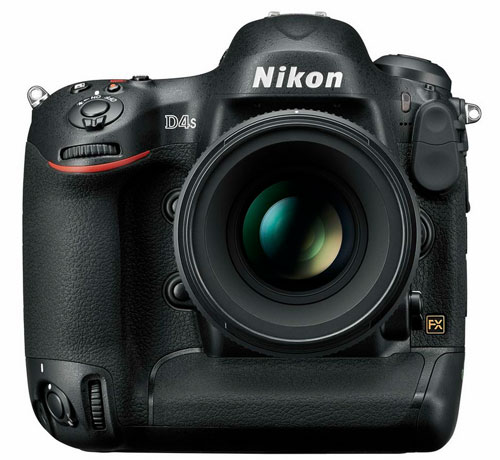
Nikon D4s announced today finally and features newly developed sensor, Expeed 4 image processor and 11fps of continuous shooting mode with Auto-focus tracking.
Pre-order Nikon D4s at Amazon, B&H and Adorama
By admin, on February 19th, 2014
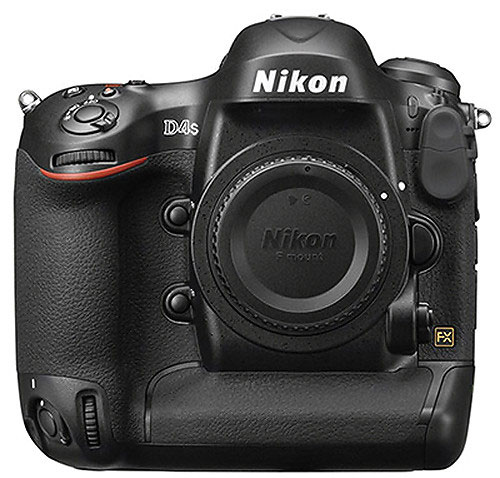
According to latest Rumors surfaced over the web the Nikon D4s is expected to be announced on Feb 25th, 2014., take a look at the rumored specification and all available information of Nikon D4s
Rumored Specification of Nikon D4s
- Sensor Same as Nikon D4 (16 MP) / but some other sources are saying its a 24MP FF FX-Format sensor.
- 3D-Tracking in 9 or 21 points group
- ISO: 100-25,600 (Native ISO range)
- HD movie at 60 fps/1080p
- Improved time-lapse movie recording
- Improved white balance
- LCD screen with adjustable screen tone
- Shipping will start in March or latest April
The Camera Box Will include
- Nikon D4S HDSLR Camera
- Rechargeable Li-ion Battery EN-EL18
- Battery Charger MH-26
- USB Cable UC-E15
- USB Cable Clip
- Camera Strap AN-DC7
- Body Cap BF-1B
- Accessory Shoe Cover BS-2
- Eyepiece DK-17
- Battery Chamber Cover BL-6
- UF-2 Connector Cover
- UF-1 Connector Cover
- Nikon View NX2 CD-ROM
- Nikon 1 Year Warranty
stay with us on social network to get every bit of information related to Nikon D4s. Join us on FACEBOOK | TWITTER | GOOGLE+ to get live news + rumors 24X7.
src – NikonRumor
|
KEEP THIS BLOG ALIVE - Support New Camera Buy Canon Lenses, Buy Music CD or Digital Camera at amazon it helps this site, and you do not pay anything extra, it is just a way to help support this site.

|




















